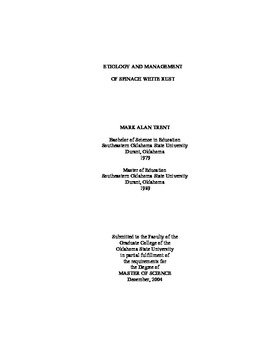| dc.contributor.author | Trent, Mark Alan | |
| dc.date.accessioned | 2014-04-15T21:16:57Z | |
| dc.date.available | 2014-04-15T21:16:57Z | |
| dc.date.issued | 2004-12-01 | |
| dc.identifier.uri | https://hdl.handle.net/11244/9018 | |
| dc.description.abstract | The purpose of this study was three fold; to analyze the effectiveness of various fungicides and initiation dates for calendar-based and weather-based spray programs for control of spinach white rust, to assess oospores as a source of primary inoculum for spinach white rust and to determine the activity of these fungicides at various periods after inoculation with conidia of Cercospora leaf spot. Field plots were treated with the fungicides according to a 7-day calendar program and a weather-based spray advisory program with an early, middle, and late initiation of the programs. The effects of fungicide, efficacy of spray programs and initiation dates on levels of white rust were evaluated. Oospores of the white rust pathogen were subjected to various treatments to encourage germination, and the resulting zoospores were inoculated to greenhouse plants to determine there pathogenicity. Fungicides were applied to greenhouse plants 1 day before, immediately before, and 1 to 5 days following inoculation of the plants with the secondary causal agent of the disease. Pyraclostrobin was the most effective fungicide against white rust. However, azoxystrobin, zoxamide, and fosetyl-Al also provided good disease control. The middle initiated calendar-based program was the most efficient while the use the use of the middle initiated advisory program provided only slightly higher levels of disease but required 54% fewer sprays. Oospores agitated in water on a rotary shaker for 72 hours produce zoospores and these zoospores were shown to be pathogenic on spinach. The use of azoxystrobin and pyraclostrobin provided 4 days of post-inoculation activity against Cercospora leaf spot. However, pyraclostrobin provided a higher level of disease control when used 2 to 4 days after inoculation compared to azoxystrobin. Zoxamide and maneb were not effective when used post-inoculation against Cercospora leaf spot. | |
| dc.format | application/pdf | |
| dc.language | en_US | |
| dc.publisher | Oklahoma State University | |
| dc.rights | Copyright is held by the author who has granted the Oklahoma State University Library the non-exclusive right to share this material in its institutional repository. Contact Digital Library Services at lib-dls@okstate.edu or 405-744-9161 for the permission policy on the use, reproduction or distribution of this material. | |
| dc.title | Etiology and Management of Spinach White Rust | |
| dc.type | text | |
| osu.filename | Trent_okstate_0664M_1111.pdf | |
| osu.college | Agricultural Sciences and Natural Resources | |
| osu.accesstype | Open Access | |
| dc.description.department | Department of Entomology and Plant Pathology | |
| dc.type.genre | Thesis | |
| dc.subject.keywords | spinacea oleraceae | |
| dc.subject.keywords | albugo occidentalis | |
| dc.subject.keywords | disease management | |
| dc.subject.keywords | oospore germination | |
| dc.subject.keywords | spray advisory | |
| dc.subject.keywords | post-infection activity | |
